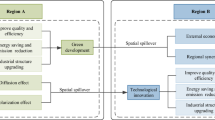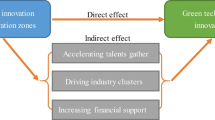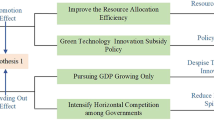Abstract
Green technology innovation is an important way to solve the dilemma of economic growth and environmental protection, while the relevant policies issued by the government have an important impact on the promotion of regional green technology innovation. This paper regards the implementation of the Regional Planning of Yangtze River Delta (RPYRD) as a quasi-natural experiment, using the panel data of 274 cities in China from 2003 to 2016 to explore the green technology innovation effect of regional planning and its transmission mechanisms through the double-fixed effect model and the difference-in-difference (DID) method. The results show that (1) the implementation of the RPYRD promotes regional green technology innovation significantly and the green technology innovation effect of the policy is increasing year by year. (2) There is significant regional heterogeneity in the incentive effect of green technology innovation in regional planning. The policy effect is more obvious in cities with a larger scale, a higher level of human capital and less resource dependence. (3) The regional planning promotes green technological innovation by optimizing industrial structure, reducing FDI and increasing R&D investment.




Similar content being viewed by others
Data availability
The datasets used and/or analyzed during the current study are available from the corresponding author on reasonable request.
References
Acemoglu D, Aghion P, Bursztyn L, Hemous D (2012) The environment and directed technical change. Am Econ Rev 102:131–166
Angrist, J. D., Pischke J.S., 2009. Mostly harmless econometrics: an empiricist’s companion. Princeton University Press, 12-31.
Apergis N, Payne JE (2009) CO2 emissions, energy usage, and output in Central America. Energy Policy 37:3282–3286
Ayamba EC, Chen HB, Ibn MAA, Ruth A, Osei AA (2019) An empirical model on the impact of foreign direct investment on China’s environmental pollution: Analysis based on simultaneous equations. Environ Sci Pollut Res 26:16239–16248
Bertrand M, Duflo E, Mullainathan S (2004) How much should we trust differences-in-differences estimates? Q J Econ 119:249–275
Bianchi P, Labory S (2019) Regional industrial policy for the manufacturing revolution: Enabling conditions for complex transformations. Camb J Reg Econ Soc 12(2):233–249
Borras S, Jordana J (2016) When regional innovation policies meet policy rationales and evidence: A plea for policy analysis. Eur Plan Stud 24(12):2133–2153
Cai XA, Lu YB, Wu MC, Yu LD (2016) Does environmental regulation drive away inbound foreign direct investment? Evidence from a quasi-natural experiment in China. J Dev Econ 123:73–85
Cai X, Zhu BZ, Zhang HJ, Li L, **e MY (2020) Can direct environmental regulation promote green technology innovation in heavily polluting industries? Evidence from Chinese listed companies. Sci Total Environ 746:140810
Calel R, Dechezleprêtre A (2016) Environmental policy and directed technological change: evidence from the European Carbon Market. Rev Econ Stat 98:173–191
Cao Y, Wan NN, Zhang HY, Zhang XL, Zhou Q (2020) Linking environmental regulation and economic growth through technological innovation and resource consumption: analysis of spatial interaction patterns of urban agglomerations. Ecol Indic 112:106062
Chen MX, Liu WD, Tao XL (2013) Evolution and assessment on China's urbanization 1960-2010: Under-urbanization or over-urbanization? Habitat International 38:25–33
Chua SC, Oh TH (2011) Green progress and prospect in Malaysia. Renew Sust Energ Rev 15:2850–2861
De Loë RC, Murray D, Michaels S, Plummer R (2016) Policy transfer among regional-level organizations: Insights from source water protection in Ontario. Environ Manag 58(1):31–47
Dechezleprêtre A, Sato M (2017) The impacts of environmental regulations on competitiveness. Rev Environ Econ Policy 11:183–206
Ding ST, Zhang M, Song Y (2019) Exploring China’s carbon emissions peak for different carbon tax scenarios. Energy Policy 129:1245–1252
Dong ZQ, He YD, Wang H, Wang LH (2020) Is there a ripple effect in environmental regulation in China? Evidence from the local neighborhood green technology innovation perspective. Ecol Indic 106773
Fabrizi A, Guarini G, Meliciani V (2018) Green patents, regulatory policies and research network policies. Res Policy 47:1018–1031
Fracasso A, Marzetti GV (2014) International R&D spillovers, absorptive capacity and relative backwardness: A panel smooth transition regression model. Int Econ J 28:137–160
Glaeser EL, Gottlieb JD (2008) The economics of place-making policies. Brook Pap Econ Act 1:155–253
Heidenreich M (2005) The renewal of regional capabilities: experimental regionalism in Germany. Res Policy 34(5):739–757
**g WM, Zhang L (2014) Environmental regulation, economic opening and China’s industry green technology innovation. Econ Res J 49:34–47
Johnstone N, Haŝĉiĉ I, Popp D (2010) Renewable energy policies and technological innovation: evidence Based on Patent Counts. Environ Resour Econ 45:133–155
Kahn ME, Li P, Zhao DX (2015) Water pollution progress at borders: the role of changes in China’s political. Promotion Incentives. Am Econ J Econ Pol 7:223–242
Kianto A, Sáenz J, Aramburu N (2017) Knowledge-based human resource management practices, intellectual capital and innovation. J Bus Res 81:11–20
Kiese M (2019) Regional cluster policies in Germany: challenges, impacts and evaluation practices. J Technol Transfer 44(6):1698–1719
Lee SH, Park S, Kim T (2015) Review on investment direction of green technology R&D in Korea. Renew Sust Energ Rev 50:186–193
Li JL, Xu B (2018) Curse or blessing: How does natural resource abundance affect green economic growth in China? Econ Res J 53:151–167
Li HJ, Graham DJ, Majumdar A (2012) The effects of congestion charging on road traffic casualties: a causal analysis using difference-in-difference estimation. Accid Anal Prev 49:366–377
Lin BQ, Chen ZY (2018) Does factor market distortion inhibit the green total factor productivity in China? J Clean Prod 197(1):25–33
Liu HX, Han BL, Wang L (2018) Modeling the spatial relationship between urban ecological resources and the economy. J Clean Prod 173:207–216
Luo YM, Fan LM (2015) The role of land in growth of farmer’s income: Protection or obstacle? Econ Res J 50(8):146–161
Luo YS, Salman M, Lu ZN (2021) Heterogeneous impacts of environmental regulations and foreign direct investment on green innovation across different regions in China. Sci Total Environ 759:143744
Malen J, Marcus AA (2017) Promoting clean energy technology entrepreneurship: the role of external. Context Energy Policy 102:7–15
Matthews T, Marston G (2019) How environmental storylines shaped regional planning policies in South East Queensland, Australia: a long-term analysis. Land Use Policy 1:476–484
Miao CL, Fang DB, Sun LY, Luo QL (2017) Natural resources utilization efficiency under the influence of green technological innovation. Resour Conserv Recycl 126:153–161
Michael EP, Claas VDL (1995) Toward a new conception of the environment-competitiveness relationship. J Econ Perspect 9:97–118
Moodysson J, Zukauskaite E (2014) Institutional conditions and innovation systems: On the impact of regional policy on firms in different sectors. Reg Stud 48(1):127–138
Moretti E (2010) Local multipliers. Am Econ Rev 100:373–377
Nasir MA, Huynh TLD, Tram HTX (2019) Role of financial development, economic growth & foreign direct investment in driving climate change: a case of emerging ASEAN. J Environ Manag 242:131–141
Nicholas A (2016) Environmental Kuznets curves: new evidence on both panel and country-level CO2 emissions. Energy Econ 54:263–271
Papyrakis E, Gerlagh R (2004) The resource curse hypothesis and its transmission channels. J Comp Econ 32:181–193
Parr JB (2015) Neglected aspects of regional policy: a retrospective view. Environment and Planning C: Politics and Space 33(2):376–392
Perkins R, Neumayer E (2012) Do recipient country characteristics affect international spillovers of CO2-efficiency via trade and foreign direct investment? Clim Chang 112(2):469–491
Qi SZ, Lin S, Cui JB (2018) Do environmental rights trading schemes induce green innovation? Evidence from listed firms in China Economic Research Journal 53:129–143
Qian XS, Fang S (2017) Does reform on security interests system affect corporate debt financing? Evidence from a natural experiment in China. Econ Res J 52:146–160
Ren CF, Guo P, Li M, Li RH (2016) An innovative method for water resources carrying capacity research-Metabolic theory of regional water resources. J Environ Manag 167:139–146
Ricci F (2007) Environmental policy and growth when inputs are differentiated in pollution intensity. Environ Resour Econ 38:285–310
Sengupta A (2012) Investment in cleaner technology and signaling distortions in a market with green consumers. Journal of Environmental. Econ Manag 64:468–480
Shahbaz M, Nasreen S, Abbas F, Anis O (2015) Does foreign direct investment impede environmental quality in high-, middle-, and low-income countries? Energy Econ 51:275–287
Shen B, Zhu C, Li QY, Wang XF (2020) Green technology adoption in textiles and apparel supply chains with environmental taxes. Int J Prod Res:1–18
Song LY, Wang XB (2013) Key industrial policies, resource replacement and industrial productivity. Management World 12:63–77
Song ML, Tao J, Wang SH (2015) FDI, technology spillovers and green innovation in China: analysis based on Data Envelopment Analysis. Ann Oper Res 228(1):47–64
Song ML, Wang SH, Sun J (2018) Environmental regulations, staff quality, green technology, R&D efficiency, and profit in manufacturing. Technol Forecast Soc Chang 133:1–14
Song XG, Zhou YX, Jia W (2019) How do economic openness and R&D investment affect green economic growth?—evidence from China. Resour Conserv Recycl 146:405–415
Sun D, Fang J, Sun JQ (2018) Health-related benefits of air quality improvement from coal control in China: evidence from the **g-**-Ji region. Resour Conserv Recycl 129:416–423
Sylwester K (2000) Income inequality, education expenditures, and growth. J Dev Econ 63(2):379–398
Tang X, Snowden S, McLellan BC, Hook M (2015) Clean coal use in China: challenges and policy implications. Energy Policy 87:517–523
Tobias S, Martin W, Spyros A, Michael P, Christian R (2018) How different policy instruments affect green product innovation: a differentiated perspective. Energy Policy 114:245–261
Van Den Bergh JCJM (2013) Environmental and climate innovation: Limitations, policies and price. Technological. Forecasting and Social Change 80:11–23
Wang DT, Chen WY (2014) Foreign direct investment, institutional development, and environmental externalities: Evidence from China. J Environ Manag 135:81–90
Wang H, Liu HF (2019) Foreign direct investment, environmental regulation, and environmental pollution: an empirical study based on threshold effects for different Chinese regions. Environ Sci Pollut Res 26:5394–5409
Wang SS, Zhou DQ, Zhou P, Wang QW (2011) CO2 emissions, energy consumption and economic growth in China: A panel data analysis. Energy Policy 39:4870–4875
Wang QH, Qu JS, Wang B, Wang PL, Yang TB (2019) Green technology innovation development in China in 1990-2015. Sci Total Environ 696:134008
Wang LH, Wang H, Dong ZQ (2020) Policy conditions for compatibility between economic growth and environmental quality: A test of policy bias effects from the perspective of the direction of environmental technological progress. Management World 36:39–60
Wang LH, Wang H, Dong ZQ, Wang SX, Cao ZL (2021) The air pollution effect of government economic growth expectations: Evidence from China’s cities based on green technology. Environ Sci Pollut Res
Wright, G., Czelusta, J., 2007. Resource-based growth past and present. Natural resources: neither curse nor destiny. 183-211.
Xu LX, Chen HH (2020) Exploring the innovation efficiency of new energy vehicle enterprises in China. Clean Techn Environ Policy 22(8):1671–1685
Zhang H, Cao LB, Zhang B (2017) Emissions trading and technology adoption: an adaptive agent-based analysis of thermal power plants in China. Resour Conserv Recycl 121:23–32
Zhang YJ, Shi W, Jiang L (2020) Does China’s carbon emissions trading policy improve the technology innovation of relevant enterprises? Bus Strateg Environ 29:872–885
Zhao C, Luo KL (2018) Household consumption of coal and related sulfur, arsenic, fluorine and mercury emissions in China. Energy Policy 112:221–232
Zhu BZ, Zhang MF, Zhou YH, Wang P, Sheng JC, He KJ, Wei YM, **e R (2019) Exploring the effect of industrial structure adjustment on interprovincial green development efficiency in China: a novel integrated approach. Energy Policy 134:110946
Acknowledgements
We acknowledge the financial support from the National Social Science Fund of China (No.16BGL137).
Funding
National Social Science Fund of China (No.16BGL137).
Author information
Authors and Affiliations
Contributions
H.X., L.Q., and B. L1. conceived and designed the experiments. B.L2., H.W., and W.L. performed the experiments. H.X., L.Q., and B. L2. analyzed the data and wrote the manuscript. All authors read and approved the final manuscript.
Corresponding authors
Ethics declarations
Ethics approval and consent to participate
Not applicable.
Consent for publication
Not applicable.
Competing interests
The authors declare no competing interests.
Additional information
Responsible Editor: Bao**g Gu
Publisher’s note
Springer Nature remains neutral with regard to jurisdictional claims in published maps and institutional affiliations.
Rights and permissions
About this article
Cite this article
Xu, H., Qiu, L., Liu, B. et al. Does regional planning policy of Yangtze River Delta improve green technology innovation? Evidence from a quasi-natural experiment in China. Environ Sci Pollut Res 28, 62321–62337 (2021). https://doi.org/10.1007/s11356-021-14946-8
Received:
Accepted:
Published:
Issue Date:
DOI: https://doi.org/10.1007/s11356-021-14946-8




